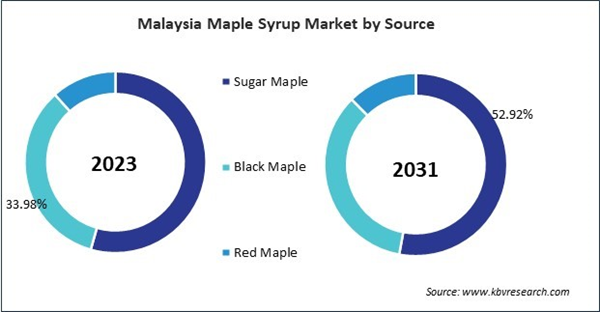In the market, supermarkets and hypermarkets serve as key distribution channels, offering a diverse range of maple syrup categories to cater to varying consumer preferences. These retail giants typically stock an extensive selection of these syrup, including organic and conventional varieties, across different grades such as Grade A (Golden, Amber, Dark, and Very Dark) and Grade B. In terms of volume, the India Market registered 1,565.86 Tonnes in the supermarkets and hypermarkets in 2023.
The China market dominated the Asia Pacific Maple Syrup Market by Country in 2023, and would continue to be a dominant market till 2031; thereby, achieving a market value of $154.9 million by 2031. The Japan market is registering a CAGR of 7% during (2024 - 2031). Additionally, The India market would showcase a CAGR of 8.4% during (2024 - 2031).
Sustainability has become a key focus in the industry, with producers implementing environmentally friendly practices such as forest management, responsible tapping techniques, and energy-efficient production methods. Supporting brands that prioritize environmental stewardship and sustainability is gaining popularity among consumers. There is growing consumer interest in artisanal and small-batch food products, including maple syrup.
Artisanal producers often highlight their craftsmanship, attention to detail, and unique flavour profiles, appealing to consumers looking for high-quality and authentic products. Moreover, while maple syrup remains popular, there is a growing market for alternative sweeteners such as honey, agave syrup, and coconut sugar. Additionally, some consumers seek to reduce their sugar intake, increasing demand for sugar-free or reduced-sugar products.
According to Invest India, Indian e-commerce is estimated to develop at a 27% compound annual growth rate, reaching $163 billion by 2026. As health consciousness increases among Indian consumers, there is a growing demand for natural and healthier alternatives to traditional sweeteners. Rapid urbanization and changing lifestyles in India have led to shifts in dietary preferences and consumption patterns. Therefore, due to the above-mentioned factors, the market will grow significantly in this region.
Based on Category, the market is segmented into Conventional, and Organic. Based on Distribution Channel, the market is segmented into Hypermarkets & Supermarkets, Specialty Stores, Online Sales Channels, and Others. Based on Source, the market is segmented into Sugar Maple, Black Maple, and Red Maple. Based on countries, the market is segmented into China, Japan, India, South Korea, Australia, Malaysia, and Rest of Asia Pacific.
List of Key Companies Profiled
- B&G Foods, Inc.
- Vermont Pleasant Valley Maples
- Ferguson Farm Vermont Maple Syrup
- Butternut Mountain Farm
- Coombs Family Farms
- Maple Joe (Famille Michaud Apiculteurs)
- Golden Dog Farm LLC
- Judd’s Wayeeses Farms
- Anderson’s Maple Syrup, Inc.
Market Report Segmentation
By Category (Volume, Tonnes, USD Billion, 2020-2031)- Conventional
- Organic
- Hypermarkets & Supermarkets
- Specialty Stores
- Online Sales Channels
- Others
- Sugar Maple
- Black Maple
- Red Maple
- China
- Japan
- India
- South Korea
- Australia
- Malaysia
- Rest of Asia Pacific
Table of Contents
Companies Mentioned
- B&G Foods, Inc.
- Vermont Pleasant Valley Maples
- Ferguson Farm Vermont Maple Syrup
- Butternut Mountain Farm
- Coombs Family Farms
- Maple Joe (Famille Michaud Apiculteurs)
- Golden Dog Farm LLC
- Judd’s Wayeeses Farms
- Anderson’s Maple Syrup, Inc.









